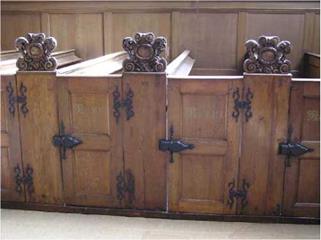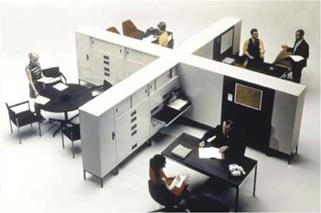Partitioning space is another determinant of function. Space can be subdivided or unified through the location and use of built-in furnishings, privacy screens, and shelving systems. Consider how built-in and partitioned pews have influenced the perception of interior space in many older churches and cathedrals across Europe (Figure 2.25). At the other end of the spectrum, consider the many office environments, hotel lobbies, museum exhibits, libraries, and restaurant spaces in which freestanding furniture functions to partition and define zones of activity, independent of the interior or architectural frame. Office storage systems can provide flexible arrangements, dividing and subdividing large spaces into more manageable spaces or more private spaces (Figure 2.26). Residential fire screens help control the heat from an open fire and in so doing provide a greater utility for those near a fireplace.
![]()
|
|
|
Classifications based on social use
Furnishings facilitate social use and the functional needs required in many different environments. Social-use classifications include:
Health-care furniture:
Nurse stations Hospital beds
Examination chairs and tables Wheelchairs Hospitality furniture:
Restaurant dining (tables and chairs) Serving stations Lobby and vestibule seating Institutional and educational furniture: Chairs and tables Desks
Podium/lectern Multifunctional furniture:
Sit-work Sit-sleep Store-display Office furniture:
Ergonomic task chairs Workstations Filing cabinets Shelving systems Recreational furniture:
Camping Gaming furniture Leisure
Adirondack chair Porch rocker Porch swing Playground equipment Poolside
Sports-watching Religious (Liturgical) furniture:
Catholic Altar Ambo Ambry Cantor stand Credence table Gift table Lectern
Presider’s chair Processional cross Tabernacle
Jewish
Ark
Lectern Ritual table
Torah table
Islamic
Minbar Prayer rug
■ Residential furniture:
Bedroom
Blanket chest Bunk bed Canopy bed
Chest of drawers
Chest-on-chest
Daybed
Four-poster bed Futon Highboy Lowboy Side table
Trundle bed
Dining room
Breakfront Buffet Dining chair Dining table Drop-leaf table
Gateleg table
High chair Hutch
Pedestal table
Living room
Coffee table
Love seat
Multimedia display and storage
Nested tables Reclining chair Settee
Shelving Side table Sofa
Tea table Nursery
Changing table Crib
■ Retail furniture:
Cashwrap
Product display Shelving/product storage
■ Storage furniture:
Shelving
Retail stores, online web sites, catalogs, and custom fabrication companies market specialized furniture using social-use headings to reach targeted audiences who might be looking for specific use or specific type furniture categories.
Social-use needs change over time. Retailers try to keep current with social-use trends and respond by offering new products to satisfy the changing demand. Consumers want safe furnishings for newborn babies, nontoxic products, and finishes that emit few volatile organic compounds (VOCs). Multimedia furnishings are designed to be much slimmer today, catering to a shift in the market toward thinner, smarter TVs. Many outdoor residential furnishings are lightweight, comfortable, and designed to resist fading or damage caused by the sun. Home goods is a phrase used by many retailers to describe lifestyle (residential) design. Arhaus, IKEA (Figure 2.27), Macy’s, Target, and Williams-Sonoma are retail corporations that offer lifestyle furnishings and target middle – to upper-middle-class consumers.





